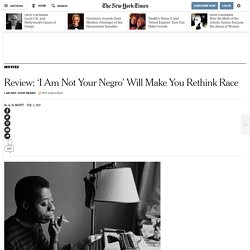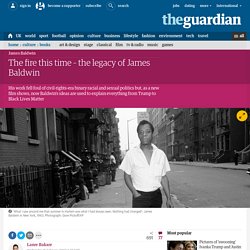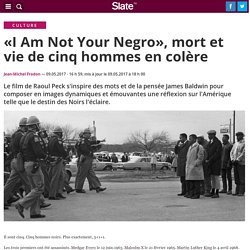

Revolutionary Hope: A Conversation Between James Baldwin and Audre Lorde. The Museum of Contemporary African Diaspora Arts republished this conversation between iconic Black thinkers James Baldwin and Audre Lorde on their Tumblr page.

The conversation took place at Hampshire College in Amherst, MA and was was originally published in ESSENCE in 1984. The dialogue reveals the importance of recognizing that shared racial histories cannot overshadow the divergent gendered histories between Black men and women. JB: One of the dangers of being a Black American is being schizophrenic, and I mean ‘schizophrenic’ in the most literal sense. To be a Black American is in some ways to be born with the desire to be white. It’s a part of the price you pay for being born here, and it affects every Black person. AL: I don’t, honey. JB: You are saying you do not exist in the American dream except as a nightmare. AL: That’s right. AL: Even worse than the nightmare is the blank. JB: I agree. ET MON CACHOT TREMBLA (Letter to My Nephew) - lu Par Samuel LÉGITIMUS by Collectif James Baldwin. Review-i-am-not-your-negro-review-james-baldwin.html?_r=0&referer= Baldwin is a double character in Mr.

Peck’s film. The elegance and gravity of his formal prose, and the gravelly authority of Mr. Jackson’s voice, stand in contrast to his quicksilver on-camera presence as a lecturer and television guest. In his skinny tie and narrow suit, an omnipresent cigarette between his fingers, he imports a touch of midcentury intellectual cool into our overheated, anti-intellectual media moment. A former child preacher, he remained a natural, if somewhat reluctant, performer — a master of the heavy sigh, the raised eyebrow and the rhetorical flourish.
« Black America : Cette fois le feu » (1/4) : “La prochaine fois, le feu” Une série de François-Xavier Trégan, réalisée par Rafik Zénine Ce 18 septembre 2016, tout ce que la communauté afro-américaine compte de personnalités et d’associations défile dans les rues de New York.

De la 111ème à la 136ème rue, les Harlémites s’entassent le long du parcours. La 47 ème African American Day Parade tient ses promesses d’automne, de kermesse, de chars et de chants. Pourtant, l’avant veille, à Tulsa, Oklahoma, un “noir”, non armé, a perdu la vie sous les balles de la police. JAMES BALDWIN INTERVIEWÉ PAR KENNETH CLARK (24 mai 1963) The fire this time – the legacy of James Baldwin. In the opening to his 1962 New Yorker essay Letter from a Region in My Mind, James Baldwin remembers walking around his neighbourhood of Harlem as a 14-year-old, wondering if his fate would trap him there.

“What I saw around me that summer in Harlem was what I had always seen,” he wrote. “Nothing had changed.” More than 60 years on, Baldwin’s words and philosophy have travelled thousands of miles from 110th street. His public image has been on a journey, from literary sensation with his debut novel Go Tell It on the Mountain in 1952 to his searing non-fiction work in the 60s that saw him revered as one of America’s most prominent public intellectuals. Thirty years since he died of stomach cancer in 1987, an expat in the south of France, there is reinvigorated interest in Baldwin and his ideas. Peck’s film is the latest in a string of events and retrospectives that have put Baldwin back in the public imagination. “He had the longer view,” says Peck. Return of the Prophet: Baldwin in the 21st Century - Open Source with Christopher Lydon. 30 years after his death, James Baldwin is having a new pop culture moment.
Every writer hopes his prose will persist, but James Baldwin made an especially solid bet: As long as the disease of American racism, resentment of homosexuals, and the nation’s strange relationship with social class and capitalism lasted, his work, he knew, would matter.

But when Baldwin died 30 years ago, it would have been hard to predict that books such as “The Fire Next Time” — written as a letter to his nephew on the 100th anniversary of black emancipation — or “Giovanni’s Room” — a slender, once-obscure novel about a purportedly straight American and an Italian bartender who fall in love in Paris — would half a century later sit at the center of the zeitgeist. “Baldwin is back,” says Harvard literary critic and historian Henry Louis Gates. “Bigger and badder than ever.” But part of it is because Baldwin has stirred artists and writers in ways that no scribe of any color has done lately. But the debt to Baldwin is direct. Often, though, he was buried by respectful neglect. How James Baldwin's The Fire Next Time still lights the way towards equality.
There is never a bad time to encounter James Baldwin, and as the wide success of the Oscar-nominated documentary I Am Not Your Negro has made clear, the appetite in Trump’s America for his prescient brilliance on race and civil rights is fierce and growing.

His 1962 classic The Fire Next Time was originally a letter, written by Baldwin to his nephew on the 100th anniversary of the so-called emancipation of black America. In the letter’s penultimate paragraph, Baldwin writes: “This is your home, my friend, do not be driven from it; great men have done great things here, and will again, and we can make America what America must become.” It is rhythmically similar to Trump’s red-hatted mantra – but there’s a big difference between trying to make America “great again” and focusing on what it once was, rather than what it “must become”.
Schapiro and Baldwin showed the possibility of what strong writing and photography could achieve in their time. I Am Not Your Negro review – astonishing portrait of James Baldwin's civil rights fight. Raoul Peck’s outstanding, Oscar-nominated documentary is about the African American activist and author James Baldwin, author of Go Tell It on the Mountain and The Fire Next Time.

Emission spéciale avec Raoul Peck, 1/2. La puissance imparfaite de « I Am Not Your Negro » La prochaine fois le feu (James Baldwin) – DIACRITIK. Le livre de James Baldwin, La prochaine fois le feu, publié aux USA en 1963, est un texte autobiographique où l’auteur parcourt son enfance et sa vie de jeune adulte triplement discriminé — noir, homosexuel et pauvre.

Ce parcours produit aussi une analyse des mécanismes d’une discrimination raciale ne pouvant être réduite à la violence physique. Celle-ci, subie par les Noirs, est à peine évoquée et apparaît surtout comme le fait d’une police qui sert moins à garantir la tranquillité de tous qu’à maintenir l’ordre inégalitaire d’une société blanche.
Cependant, qu’il soit fait allusion à la violence policière permet de saisir le lien existant entre les institutions et l’idéologie discriminatoire. La police apparaît comme une institution idéologique, au sens qu’Althusser donne à cette notion. Baldwin montre que la machine discriminatoire raciste conduit le Noir à intégrer les schémas qui le font vivre et se penser du point de vue du Blanc. Sur le même thème Dans "Actualités" Dans "Livres" Emission spéciale avec Raoul Peck 2/2. Raoul Peck «Baldwin a été mon mentor politique et moral» Fr rdcvrr l’crvn mrcn Jms Bldwn.

«I Am Not Your Negro», mort et vie de cinq hommes en colère. Il sont cinq.

Cinq hommes noirs. Plus exactement, 3+1+1. Les trois premiers ont été assassinés. Medgar Evers le 12 juin 1963. Malcolm X le 21 février 1965.